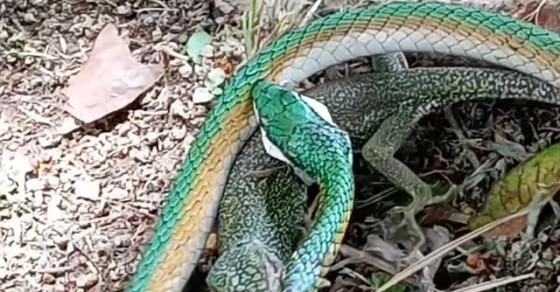
The sungazer lizard has impressive spikes that cover its body, including the tail. The armadillo lizard has sharp, spiky scales and can roll up into a tight ball to protect its soft belly from attack. Horned lizards are able to squirt blood from tiny blood vessels in their eyes to scare away or confuse a predator. Other lizards have different ways to stay safe. Still, it’s better than being someone else’s dinner! It can grow back over time, although the tail won’t look quite the same. If a predator grabs the lizard by its tail, the tail easily comes off. The tail has a weak spot just for this purpose. Several types of lizards are able to escape from an enemy’s grasp by breaking off part of their own tail. Their camouflage and ability to stay still for hours helps keep them safe. Lizards are popular prey for many types of predators, from birds of prey to snakes and carnivorous mammals. Skinks have smooth scales so mud won’t cling to them some lizard species have bony plates, called osteoderms, under their scales for added protection against rough terrain. The scales on lizards vary, depending on their habitat.
#Lizard snake escape skin
The exception to this is with the alligator lizard, which may shed its skin in one piece, like a snake. Instead, most lizards shed, or molt, their old skin in large flakes to make way for the new skin growth underneath. Lizards have dry, scaly skin that does not grow with their bodies. Even so, lizards can’t hear as well as we do, but their hearing is better than that of snakes. Instead, they have visible ear openings to catch sound, and their eardrums are just below the surface of their skin. Lizards don’t have earflaps like mammals do. The lizard can use these scent “clues” to find food or a mate or to detect enemies. Lizards smell stuff with their tongues! Just like snakes, a lizard sticks out its tongue to catch scent particles in the air and then pulls back its tongue and places those particles on the roof of its mouth, where there are special sensory cells. Blue-tongued skink using his eponymous tongue to smell. Their colorful body parts allow them to communicate with each other and help them tell which are male and which are female. Many lizards, such as iguanas, can see in color. But some lizards, like geckos, can’t blink! Instead, they have a clear membrane that shields their eyes from dirt or bright sun and use their tongue to clean their eyes. Most lizards have eyelids, just like we do, that clean and protect their eyes when they blink. Geckos, like this banded-knob tailed gecko, have clear membrane shields over their eyes in lieu of eyelids. There are currently over 4,675 lizard species, including iguanas, chameleons, geckos, Gila monsters, monitors, and skinks. Unlike snakes, most lizards have moveable eyelids. In general, lizards have a small head, short neck, and long body and tail. Their ancestors appeared on Earth over 200 million years ago. In fact, some lizards, called sheltopusiks, look like snakes because they have no legs! Many lizards today resemble the ancient reptiles of the dinosaur era. This went on for some time and the lizard eventually stopped moving.What is a lizard? Lizards are part of a group of animals known as reptiles. Unfortunately for the lizard, the snake caught it again (once in the face).


It had clear bite wounds in its neck and it was covered in venom.” “Despite this, incredibly, the lizard was able to escape the snake’s jaws a couple of times and made a swift exit. “As time went on I could see that the lizard was flagging. I didn’t want to move my car in case I spooked the snake – this meant that they got a bit too close for comfort (at one point they were both tangled up partly under my car).” “The lizard showed immense strength as it dragged the snake up the road. I approached slowly and was amazed to find a massive cobra (snouted cobra is the consensus) trying to take on a large monitor lizard.” Not too far down the road, I came across a very odd looking shape in the distance and I could not make out what it was. I left Shingwedzi camp as the gates opened and headed off down to Letaba. Helen tells : “In April this year, I was on a solo trip to Kruger as my husband went climbing. Send in your wildlife video here, and earn money: Click Here

This snake was out and about trying to grab himself a mammoth meal as he took on this sizable monitor lizard… They are predominantly nocturnal but are often encountered during the day in the bushveld as Helen Young discovered. The snouted cobra is an aggressive snake and they are potently neurotoxic and classified as highly dangerous.


 0 kommentar(er)
0 kommentar(er)
